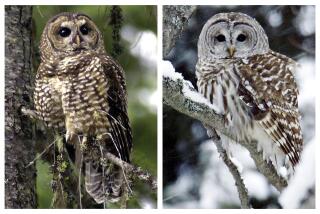U.S. Officials Drop Wildlife Protections From Forest Plan
Federal officials Tuesday dropped some wildlife protections from the Northwest Forest Plan, a set of rules adopted by the Clinton administration that slashed timber harvest levels on federal land in the Pacific Northwest and parts of Northern California.
The revisions, in the works for a year, deal with water protections and eliminate a requirement that before logging, forest managers look for rare plants and animals associated with old-growth trees.
Federal agencies said the searches were time-consuming and expensive, making it difficult to meet the full timber harvest levels permitted under the court-ordered Northwest plan.
“Our objective with this decision is to meet protective measures as well as the commodity production envisioned in the Northwest Forest Plan,” said Rex Holloway, Pacific Northwest spokesman for the Forest Service.
Environmentalists condemned the rollbacks and accused administration officials of pandering to timber interests.
“The Bush administration is going after two of the fundamental pieces of this plan,” said Pete Frost, an attorney with the Western Environmental Law Center in Eugene, Ore. “It is an outrageous change to a plan carefully brokered 10 years ago. And it was done largely for political reasons to pay back the timber-industry beneficiaries of the Bush administration. What we will lose is 500-year-old trees.”
The Northwest plan covers 24.4 million acres of Forest Service, National Park Service and federal Bureau of Land Management holdings, 6 million of them in Northern California. It created old-growth reserves and established streamside and wildlife protections designed to stop the decline of the threatened northern spotted owl. Timber harvests plummeted in the Pacific Northwest after it was adopted.
The reserves are not affected by the revisions, but the amendments will clear the way for more commercial logging on other lands covered by the plan that harbor old-growth trees. The U.S. Forest Service estimates that an additional 70 million board feet a year can be cut with elimination of the survey requirements.
The Northwest plan allows for an annual timber harvest of some 800 million board feet, but the actual harvest, at the most, has been half that amount.
Holloway said the management changes should not hurt owl populations, which are protected under the Endangered Species Act. But forest planners said populations of nearly 60 rare species of forest life such as mushrooms, snails and lichens could be affected.
“We really don’t think there’s much of a threat to those species,” said Anne Boeder of the Bureau of Land Management.
In addition to dropping the survey requirements, federal officials are changing the way watershed and aquatic protections are applied. Instead of making sure individual logging projects meet all the guidelines, managers will only have to meet the goals on a broader scale.
“Both of these provisions are just making it easier to log old growth,” said Jeremy Hall, northwest field representative for the Oregon Natural Resources Council. “It’s very likely that we will be suing on both of them.”
More to Read
Sign up for Essential California
The most important California stories and recommendations in your inbox every morning.
You may occasionally receive promotional content from the Los Angeles Times.











